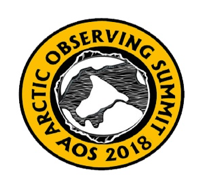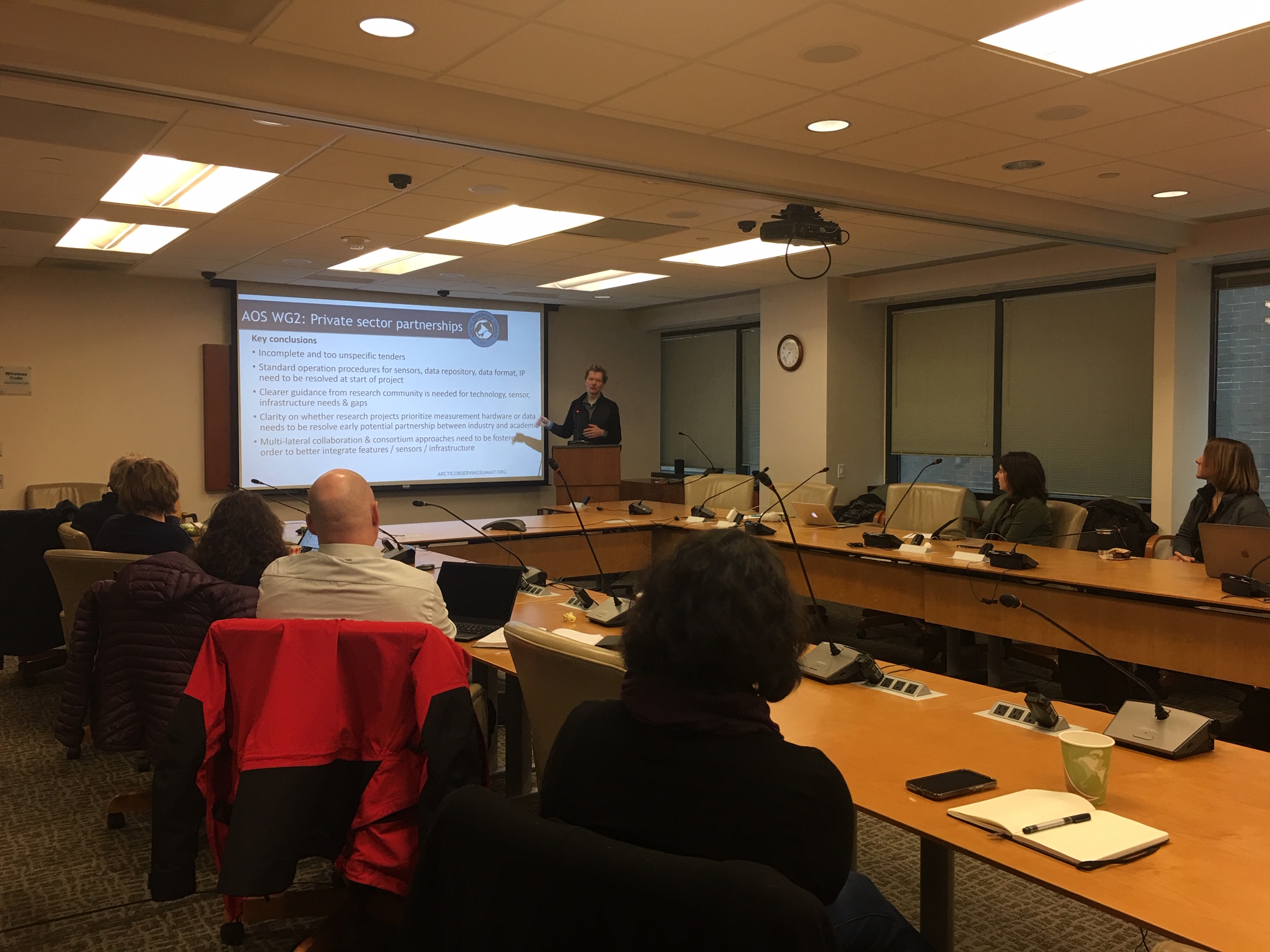By: Sandy Starkweather, Executive Director of the U.S. Arctic Observing Network

Members of the Arctic Observing Summit – Working Group on Implementation and Optimization (AOS-WIO) met on 9 December 2018 in Washington D.C. to continue work on items identified in the August 2018 AOS Call to Action that built upon insights and recommendations from the June 2018 AOS meeting held in Davos, Switzerland.
The primary purpose of the December 2018 meeting was to gather input for a draft Task Team Scope of Work supporting Sustaining Arctic Observing Network - Committee on Networks (SAON-CON) objectives:
- Objective 1.2: Complete an assessment of adequacy of the Arctic observational capacity in support of Arctic Societal Benefit Areas (SBAs).
- Objective 1.3: Provide recommendations for a roadmap for future Arctic observational capacities.
A secondary purpose was to engage a broader group of potential contributors beyond those who attended AOS in Davos. In consideration of the potential breadth of foci for this task team, the organizers anticipated that topical foci might be a pragmatic way to proceed under the task. These were explored along with other organizational considerations during the meeting.

The open meeting, co-chaired by Hajo Eicken (AOS) and Sandy Starkweather (SAON), was supported through the Arctic Research Consortium of the United States (ARCUS) and the International Arctic Science Committee (IASC). More than 20 attendees from five countries contributed. After a series of context-setting presentations, each of the participants were invited to suggest a breakout group focus.
The group identified four different areas to explore that were more conceptual and less oriented toward specific science topics. These were:
- How should a Roadmap be defined?
- What considerations will best support Indigenous community needs and a co-production of knowledge?
- What existing tools and efforts should be considered in defining a Roadmap? Thinking in dimensions of space as well as time.
- What could a Roadmap do to support interdisciplinary science?
Summary of Task Scope Recommendations from Break-Out Groups:
An overarching recommendation concerned the need for SAON to engage in an active, international dialog about what is meant by a Roadmap and what it is intended to accomplish. As a Roadmap will likely be used by funding organizations, it was viewed as critical that funders contribute to the discussion. It was further pointed out that to date, SAON strategies have been capabilities-based (i.e., driving collaboration across existing efforts) rather than requirements-based, the latter having greater strengths for sustainability.
Another recommendation was that Indigenous communities and the practices of a co-production of knowledge be integral to a Roadmap for observing, with Indigenous perspectives equitably engaged in the Roadmapping process.
The value of creating a shared assessment system, building upon the Arctic Societal Benefit Areas, that availed itself of existing inventories was clearly recognized. Also recognized was the need to be engaged with modelling communities, especially concerning findings from Observing System Experiments that could establish the value of a "pulse of activity" such as the Multidisciplinary drifting Observatory for the Study of Arctic Climate (MOSAiC). This was one example of how a Roadmap could and should include strong spatial content.
The need for a spatially "aware" Roadmap was also viewed as essential for interdisciplinary work. In addition, it was recognized that a Roadmap for observing would need to include a strong knowledge-based element to support data and information discovery across disciplines. The societal benefit structure was viewed as supportive for both this and the community-related needs from a Roadmap.
The group recognized that specific scientific foci would likely be necessary for the Task Team to accomplish something concrete, but such foci would require more time to emerge.
Arctic Observing Summit – Working Group on Implementation and Optimization: Draft Task Statement (March 2019—March 2021)
- Develop a definition for the SAON Roadmap that will serve to generate strong international investments in Arctic observing and promote synergies and interoperability among observing efforts.
- Define how Arctic Societal Benefit Areas or other objectives should be used to shape the Roadmap.
- Identify a family of scientific foci with high maturity and relevance to demonstrate the utility of the Roadmap for planning, coordination, and engagement.
- Assemble and align the relevant existing inventories and efforts under these foci.
For questions, contact Sandy Starkweather, NOAA (sandy.starkweather [at] noaa.gov).
About the Author
 Sandy Starkweather is the Executive Director for the U.S. Arctic Observing Network, a National Oceanic an Atmospheric Administration (NOAA) funded position created to advance NOAA and U.S. agency participation in partnered Arctic observing activities and work towards a framework concept for an international Arctic Observing Network (AON). With a joint background in engineering, earth science, and science policy, Sandy has worked in a consulting engineering capacity, university research, project management, and planning. During this time, she spent twelve years traveling to and from Greenland to either participate in or support Arctic field research. She maintains a strong interest in improving the effectiveness of the Arctic research enterprise, particularly in situ observational research, through building stronger collaborations among all parties who benefit from sustained Arctic observing.
Sandy Starkweather is the Executive Director for the U.S. Arctic Observing Network, a National Oceanic an Atmospheric Administration (NOAA) funded position created to advance NOAA and U.S. agency participation in partnered Arctic observing activities and work towards a framework concept for an international Arctic Observing Network (AON). With a joint background in engineering, earth science, and science policy, Sandy has worked in a consulting engineering capacity, university research, project management, and planning. During this time, she spent twelve years traveling to and from Greenland to either participate in or support Arctic field research. She maintains a strong interest in improving the effectiveness of the Arctic research enterprise, particularly in situ observational research, through building stronger collaborations among all parties who benefit from sustained Arctic observing.
